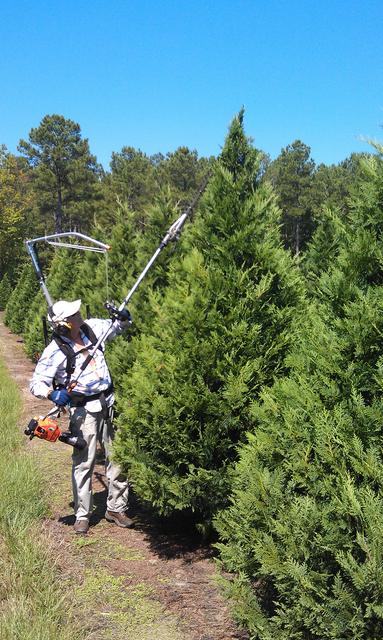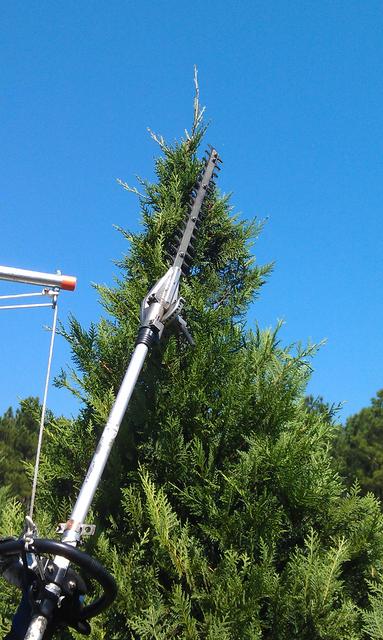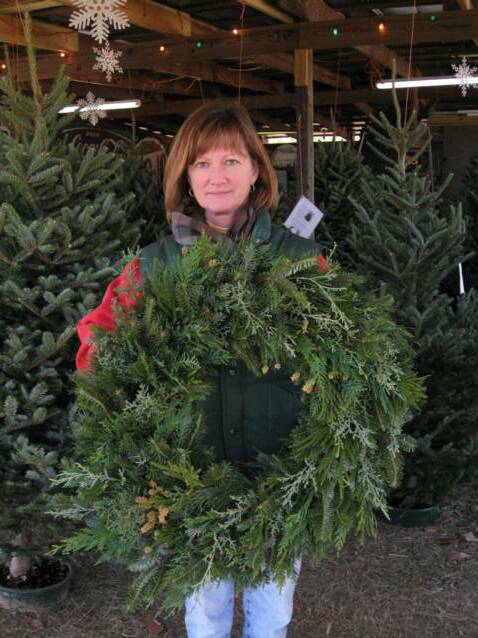Christmas Tree Farming
Throughout the Year
Every Christmas season we are repeatedly asked "What do we do all summer?" or "What do we do the rest of the year?" The question is usually asked in a way that implies that we plant the trees and then go fishing until it is time to sell them.
In a sense, raising Christmas trees is a bit like raising children. Planting them is the easy part, then the real work begins. We have to care for them (weeding, mowing), treat their ailments (insects and pests), feed them (water and fertilizer), discipline them (shearing), and so on for 5-10 long years. As with kids it is a combination of smiles, frowns, and tears. We do have one big advantage over raising kids--just as the trees are reaching their teen-age years we can sell them off!
Seriously though, Christmas trees are considered to be one of the most labor intensive of all farm crops. We hope this month by month look at the operational aspects of tree farming will give you a better feel for what we do all year long and year after year to create that "best ever" Christmas tree for your family's holiday experience. View this page as a work in progress.
January
In January, not really having had any time off since we started setting up for the season the prior October, what we do is mostly catch up on our rest. And catch up on all the office work (bills) that accumulated over the November/December sales season. Also we hope for some warm weather so we can begin to take down some of the outdoor props and displays. It's also the time to get started on the tax stuff.
February
By February we're back at it. For sure we have to get the taxes out of the way because we won't have time come March or April. Now we can start the field cleanup. We go through each field and cut out the lower branches and stumps left over from the previous season. It makes for lots of bending and hauling, but gets the fields nice and clean and makes them much easier to maintain. February is a long and hard, but exciting month for us. The new trees are arriving and when they do we want to get them into the ground as quickly as possible. We generally refer to them as seedlings, but they are actually transplants. The new transplants are progagated from cuttings taken from an older tree then rooted in liners. They are later transfered to a gallon size pot. It may take from one or two years before the trees are ready for planting in our fields. The transplanting produces a much hardier tree stock with a much more developed root structure.
March
By late March and early April, the grass and weed growth seem relentless and mowing becomes a weekly chore. We currently use two zero turn mowers. One mower with a 48 inch cut and the other larger mower has a 60 inch cut. We also have a larger tractor with bushhog for cutting the parking areas and the open fields.
April
Still mowing grass almost daily to stay ahead of the weeds! Mid to late April we start our fungicide spray program. This is a monthly spray program that that will last from April to September that involes spraying all our Leyland, Murray and Arizona Cypress trees. That is correct; every tree every month!
May
Now it is time to start our Christmas tree shearing. Shearing is a term used by Christmas Tree growers meaning we give each of our Christmas Trees a haircut twice a year. Many people think that Christmas trees naturally assume their filled-in symmetry, but, like kids, trees need discipline or else they will grow "wild". Every tree on the farm, once it approaches waist high, must be sheared twice each year. If a tree is missed it tends to become too wild and loose to properly shape as a Christmas tree. The type of tree and the age of the trees dictates their time to be sheared. A lot of trial and error over the last 39 years in developing my shearing techniques and the correct timing of the shearing.
This task takes the entire summer and sometimes into early September. It gives us lots of time to enjoy the heat and humidity, deer flies and mosquitoes, wasps, yellow jackets and ticks. Makes you wonder…
June
Time to start our herbicide program! By June the weeds and grasses are in full bloom. We spray herbicide within the row of trees and around each tree. This prevents the weeds from competeing with the growth of our Christmas Trees and allows more air flow which helps control potential fungus. This also makes grass cutting easier since we only mow between the tree rows. We will spray at least 2 or 3 herbicide applications in each field during the summer.
July
We do take a long weekend at the lake or beach to enjoy and celebrate "The 4th of July". But then it is back to the farm for more grass cutting, fungicide spraying, herbicide spraying and tree shearing. Before the end of July we make sure our baby trees have been ordered for next years planting.
August
Tree shearing starts all over again. Of course, we have never stopped shearing to some degree. This shearing is our 2nd major shearing on our larger trees that will be ready for you this Christmas Season. And the heat just keeps getting hotter and the mosquitoes are getting larger! More mowing.....More spraying......!
Shearing is such a long hard job we just wanted to talk about it again. We start in the Virginia Pine field first followed by the Arizona Cypress. By mid mid August we are done with all the pines and Arizona Cypress. Next we shear the Leyland and Murray Cypress . Actually it helps (a little) to think of shearing as an art form. The artist sculptures, the grower shears. There is a satisfaction in both… in our case only after the fact.
August is also the month the Southern Christmas Tree Association holds it's summer convention. It is held at a member's farm on a Friday/Saturday/Sunday. Most of the sessions are held at an area hotel or convention center. The following day the meeting moves to the Christmas tree fields of the member hosting the convention and are supported by experts from the Christmas tree industry as well as equipment vendors demonstrating their products. Also our National Christmas Tree Association has its' annual convention somewhere in the country during August.
September
September should be an easier "in-between" month, but rarely is. One major task that Frank takes on is to mow the entire farm. Not just the lanes, but between each row of trees. There are several reasons for this, first, to make it easier and safer for people to roam about at Christmas time while searching out their tree. The second reason is to remove as much cover as possible from the field that mice and rabbits love which includes the bark of the younger trees in their winter diet. Another reason is to spot any armadillo holes that need filling. A person could easily step in one and injure an ankle.
September is generally the time we try to freshen-up things a bit with some painting and staining. Lucie is usually busy touching-up some of the older props and making some new ones. Frank is back at the barn repairing broken spray equipment getting ready for the October color application....... usually in panic mode..
October
Inventory time! We inventory our Christmas supplies that we will need for the fast approaching Christmas selling Season. We order our tree stands, tree netting, children's color books, tree pricing tags, flagging ribbon, advertising flyers, candy canes, marking pins, wreath rings, tree colorant, hot chocolate, soft drinks, etc.......! We reorder our new cool looking tee shirts for our employees; so they can be easily recognized and ready to help you with your tree. We then have to make sure all our advertising is lined up and ready for release to the local newspapers and TV station which will start sometime mid November.
October is time for another significant activity…greening.
All the pines and most of the Leyland and Murray Cypress have to be "greened" in early fall. This is because when the temperature starts to go below 32 degrees later in the fall, the trees quit making chlorophyll which is necessary to keep the needles a true green. Instead of being "evergreens" they become "everpales". The greening is a harmless, non-toxic water based paint that keeps them looking like they did in mid-summer. At the time of application it's difficult to determine which pines have or have not been greened because they all are a lush green. However, by November the difference is striking.
November
We contact our pre-cut Christmas tree supplier to make sure the delivery of our pre-cut Fraser Fir and Spruce trees are still on the scheduled delivery date. We usually get our pre-cut trees delivered one or two day before Thanksgiving Day. Now it's time to release our Christmas Tree advertising to the newspapers and the TV stations. During late November, Lucie is busy making her custom Christmas wreaths.
In the earlier part of November we go through the fields and individually price the trees available for sale this year. This is a time consuming task, but we feel that it allows us to better manage our inventory. For example, if two trees are starting to crowd each other, we can discount one to make sure it is taken. Also not all trees are identical and we can vary the price to match the quality. We also need to make sure some are held back for next year. As we are doing the pricing, we are on the lookout for any trees that appear to be diseased or stressed. We make sure they are not priced as they probably won't hold their needles well if cut. If severe we'll cut them out and add them to the burn pile. That's one reason why people come in from the fields and say "all the trees look so nice".
As we get further into the month we start our setup. We want to make sure that any prop or sign that requires digging a hole (and that's most things) is in place before the end of the month.
It is also the time to get all the Christmas season equipment such as the shakers and balers tested out and do any necessary maintenance. By now Frank is realy in panic mode.....
We open doors the weekend beforeThanksgiving (not offically open, so yo might want to call before you travel out to the farm). We are usually not that busy, but need the weekend to get any last minutes kinks out of our systems. This is the weekend for the "where is?" "who was supposed to?" and "it worked last year!" When we open big time on Thanksgiving Friday all systems had better be Green.
December
December is really an enjoyable month. The hours are long and there are no days off, but generally by then everything is up and running smoothly. We're in a "what's done is done" mode. What's not can wait for next year.
While the weekends can be hectic at times, the weekdays are slower with time to visit with returning customers. It's great to once again be saying: "Merry Christmas".
With the Christmas season comes the joy, the sharing, the warm memories of treasured family experiences. We like to think that our trees become the centerpiece of your family's holiday tradition. As you gather around your tree to open gifts, our fondest hope is that someone says: "this is the best tree ever". And then all the above effort becomes worthwhile.
,
Wadsworth
Christmas Tree Farm
3071 Dexter Road - Wetumpka, Alabama 36092






